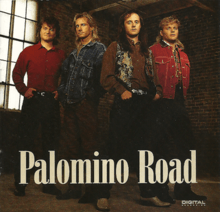Palomino Road
Palomino Road was an American country music group composed of Ronnie Guilbeau (lead vocals), J.T. Corenflos (guitar), James Lewis (drums) and Randy Frazier (bass guitar). Founded in 1992, the band recorded a self-titled album for Liberty Records, and charted with a cover of George Jones's 1955 debut single "Why Baby Why".
Palomino Road | |
|---|---|
| Origin | Nashville, Tennessee, United States |
| Genres | Country, southern rock |
| Years active | 1992-1993 |
| Labels | Liberty |
| Associated acts | George Jones, McBride & the Ride |
| Past members | J. T. Corenflos Randy Frazier Ronnie Guilbeau James Lewis |
History
All four members of Palomino Road had experience in country music prior to the band's foundation. Lead singer Ronnie Guilbeau (son of Gib Guilbeau of The Flying Burrito Brothers)[1] had played in that band before a 1980s move to Nashville, Tennessee. J.T. Corenflos, the band's guitarist, was previously a backing musician for Joe Stampley, while Randy Frazier had previously backed Sammy Kershaw and James Lewis had been active as a drummer in Nashville since the 1970s.
Palomino Road signed to Liberty Records in 1992, releasing its self-titled debut album in early 1993. This record featured no contributions from external musicians. Its first single, a cover of George Jones's 1955 single "Why Baby Why", reached number 46 on the Billboard Hot Country Singles & Tracks (now Hot Country Songs) charts. The album's second single, "The Best That You Can Do", was released in 1993 but failed to chart. The band broke up later that same year.
In 1994, Frazier joined the band McBride & the Ride as bass guitarist.[2] The lineup with Frazier disbanded in 1996. Corenflos, meanwhile, found work as a session guitarist.[3]
Palomino Road (1993)
| Palomino Road | |
|---|---|
 | |
| Studio album by Palomino Road | |
| Released | March 9, 1993 |
| Genre | Country |
| Label | Liberty |
| Producer | Thom McHugh Keith Follesé Chuck Howard |
Track listing
All songs written by Keith Follesé, Ronnie Guilbeau and Thom McHugh except where noted.
- "Why Baby Why" (George Jones, Darrell Edwards) – 2:33
- "It Works Both Ways" – 2:40
- "That's Where I Draw the Line" (Roger Ballard, Follesé, McHugh) – 3:06
- "The Best That You Can Do" – 3:52
- "Dead End Saloon" (J.T. Corenflos, Follesé, McHugh) – 4:08
- "Love Come Back" – 2:56
- "Over and Over" – 3:45
- "No Time to Stop Believing" – 3:03
- "She Rides Alone" – 3:53
- "Love Has the Last Word" (Guilbeau, Craig Wiseman) – 3:11
Singles
| Year | Single | Peak chart positions | |
|---|---|---|---|
| US Country [1] |
CAN Country | ||
| 1992 | "Why Baby Why" | 46 | 42 |
| 1993 | "The Best That You Can Do"[4] | — | — |
| "—" denotes releases that did not chart | |||
Music videos
| Year | Video |
|---|---|
| 1992 | "Why Baby Why" |
| 1993 | "The Best That You Can Do" |
References
- Whitburn, Joel (2008). Hot Country Songs 1944 to 2008. Record Research, Inc. p. 314. ISBN 0-89820-177-2.
- Mansfield, Brian (March 1994). "McBride & the Ride: Now They Are Six". New Country. 1 (1): 11.
- Bennett, Mark. "Man behind the music: Session guitarist J.T. Corenflos backs many top-name stars". Tribune-Star. Archived from the original on 2008-06-02. Retrieved 2008-08-10.
- "Single Reviews" (PDF). Billboard. May 8, 1993.